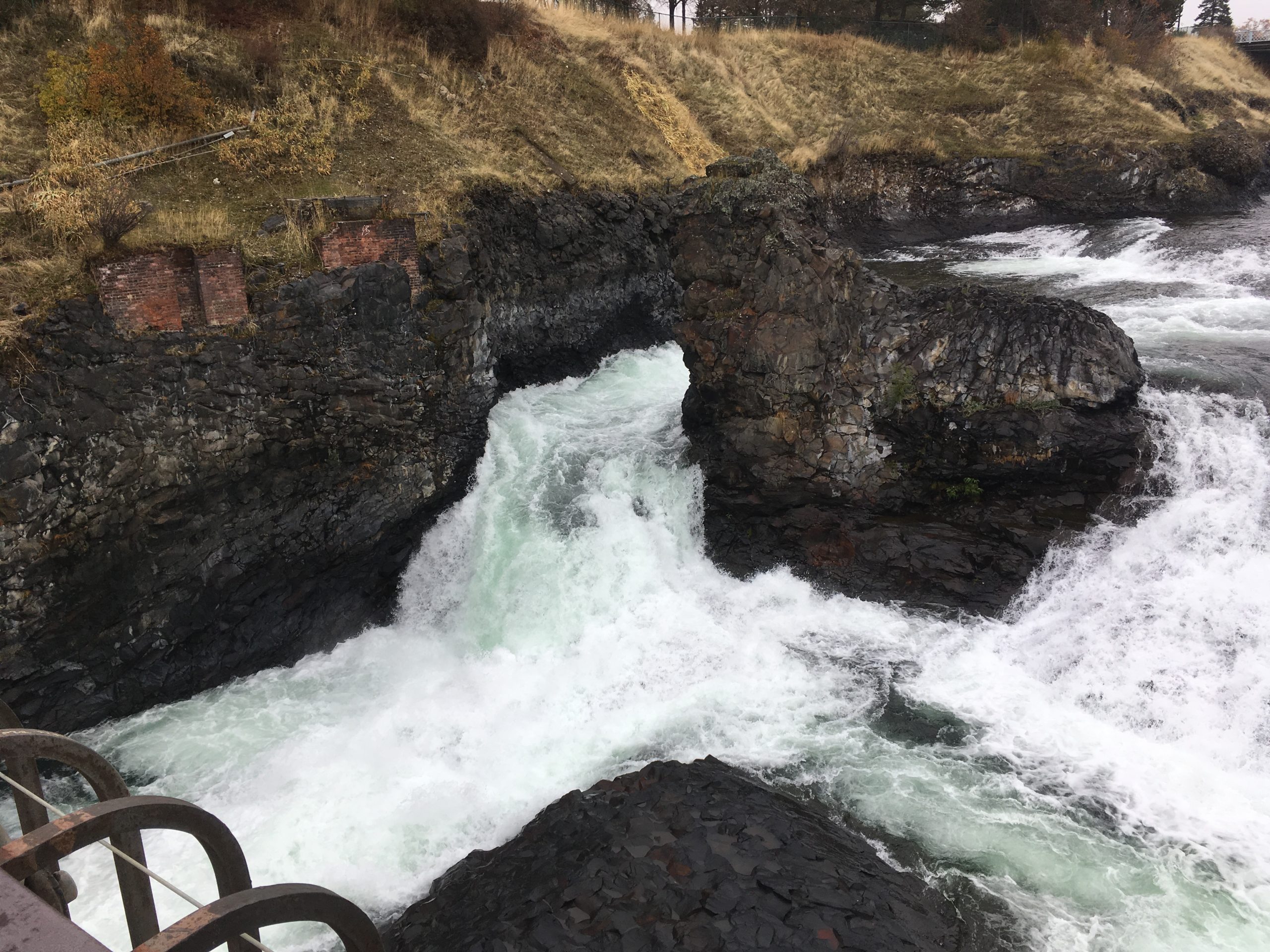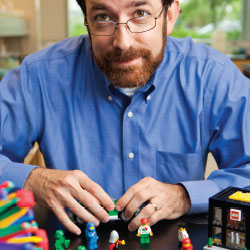
Waterfall in Spokane © Ben McFarland
My calling as a scientist is to produce and analyse protein structures, which are complex arrangements of atoms. These structures are beautiful, messy things. Because atoms have no colour, we protein scientists can paint our structures any colour we want. Most of us, myself included, choose bright, bold, primary colours, the colours of children’s toys. In our computer-generated models, the atoms are polished and shiny, reflecting virtual spotlights as if placed in a tiny photography studio.
When I think of life, I think first of proteins and their atoms, stacked up and shiny like baubles in a store window. This image of life is accurate in its details, but incomplete. Just like an old yearbook photo is an accurate but incomplete representation of you, a protein structure is a single, static image of a much more dynamic whole.
Those shiny atoms don’t belong exclusively to that protein structure. Before the carbon atoms were in the protein, they were brought into the animal as food. Before that, they may have been carbon dioxide gas that were tied together into a sugar molecule by sunlight and photosynthesis. Long, long before that, the twelve protons and neutrons that made the carbon atom were fused together inside a star.
So the proteins in my body contain atoms that are much older than me. Before I was born, my atoms were not my possession. They weren’t even my possession last year. Lynn Margulis and Dorion Sagan wrote, “Every five days you get a new stomach lining. You get a new liver every two months. Your skin replaces itself every six weeks. Every year, ninety-eight per cent of the atoms of your body are replaced.” (p.23. What is Life?) I’m only borrowing my atoms like so many library books.
My metabolism depends on atoms moving through my body, pouring in and out. With every breath and each meal, atoms pour in, changing from (CH2O)x sugar and O2 oxygen into CO2 carbon dioxide and H2O water in my cells, falling down in energy[1] so that I can persist as a stable, sentient flow. As chemical bonds shuffle to make more stable molecules, the extra energy is caught by energy-carrying ATP molecules, which my body uses to power thought and movement.
So life is a metabolic waterfall, dependent on atoms falling down in energy, always in motion and never the same twice. This image occurred to me at a specific time when I needed some specific help – and I received it, through a waterfall.
A year and a half ago, the first time I visited Spokane, Washington, I was settling in for the night at a downtown hotel. While scrolling through my phone, I received some sad news of a major loss. I was shaken. As happens in such times, my brain tossed up memories and thoughts, voices both light and dark, of truth and error, fragments of prayers – but nothing cohered.
I had to think it out, so I had to walk it out. Without map or goal, I walked into the night.
Soon I heard the roar of a waterfall, sounding much too big for a downtown park. I followed my ears and found Spokane Falls, the old powerhouse of the city. As I stood still, the turbulent, falling water matched my turbulent thoughts.
I remembered Terrence Malick’s movie The Tree of Life, which shows a rushing waterfall at its beginning and end, framing its story. I remembered how the mother in that film prayed “I give it to you.” I prayed the same. As I wrote in my journal later, “This is yours. Your gift, your power to receive. Your breath, O2 in, CO2 out.” (It’s true, I use chemical formulas in my journal.)
I thought about how the atoms I possess today will not be my possession tomorrow. I thought about how all I have is a gift from God, whether asked for or not. A sense of dependency led to a sense of gratitude.
The waterfall comforted me because I saw myself in its dynamic dependence, its constant loss and constant replenishment. There are parallels between it and me because God created us both.
The waterfall-like act of pouring out is central to what it means to be human, and to live dependent on something outside myself. When God became human, he poured out his life. The Greek word for this pouring out is “kenosis,” for “the act of emptying.”
When I first encountered the word “kenosis,” I focused on it as a state of emptiness. But Tom Oord in The Uncontrolling Love of God changed my focus, by describing kenosis as a process, not a state of being. Kenosis is the act of emptying, and the verb of pouring oneself out like a waterfall.
Jesus on the cross literally poured out his life-blood. Jesus poured out tears praying in the garden, as he chose to do what he did not want. Jesus as a teacher poured out his words, saying “I am the living water.” In each of these acts, he chose to pour out life toward us. On Good Friday he gave everything, and on Easter he received life again, greater than before, which he continues to give today.
Standing by the waterfall on that wet April night, I poured myself out to God in prayer and realized I was not alone. The ordered chaos of the waterfall mirrored the ordered chaos of life. I rested in that image.
I returned to Spokane a few weeks ago for a conference, and I walked by the waterfall again. The context was different — it was daytime, sunny, and cold — but the waterfall was still there, persistent and dependent. It was beautiful, rejoicing as it poured itself out, receiving as it gave, new every morning yet ever the same.
[1]In chemistry, more stable molecules are considered to be “down” or lower in energy, so that we can think of molecules undergoing a spontaneous reaction as being pulled down in energy by the laws of thermodynamics, like bowling balls pulled down a hill by the law of gravity to reach a more stable (lower) state.
 Ben McFarland teaches biochemistry and chemistry at Seattle Pacific University in Seattle, USA. He grew up near Kennedy Space Center and wanted to be a paleontologist in the second grade. He received a dual B.S. in Chemistry and Technical Writing from the University of Florida and a Ph.D. in Biomolecular Structure and Design from the University of Washington. His research uses the rules of chemistry to redesign immune system proteins. In 2013 he received an Evolution and Christian Faith (ECF) grant from BioLogos to write A World From Dust: How the Periodic Table Shaped Life (Oxford University Press, 2016). He lives near Seattle with his wife Laurie and his children Sam, Aidan, Brendan, and Benjamin.
Ben McFarland teaches biochemistry and chemistry at Seattle Pacific University in Seattle, USA. He grew up near Kennedy Space Center and wanted to be a paleontologist in the second grade. He received a dual B.S. in Chemistry and Technical Writing from the University of Florida and a Ph.D. in Biomolecular Structure and Design from the University of Washington. His research uses the rules of chemistry to redesign immune system proteins. In 2013 he received an Evolution and Christian Faith (ECF) grant from BioLogos to write A World From Dust: How the Periodic Table Shaped Life (Oxford University Press, 2016). He lives near Seattle with his wife Laurie and his children Sam, Aidan, Brendan, and Benjamin.



